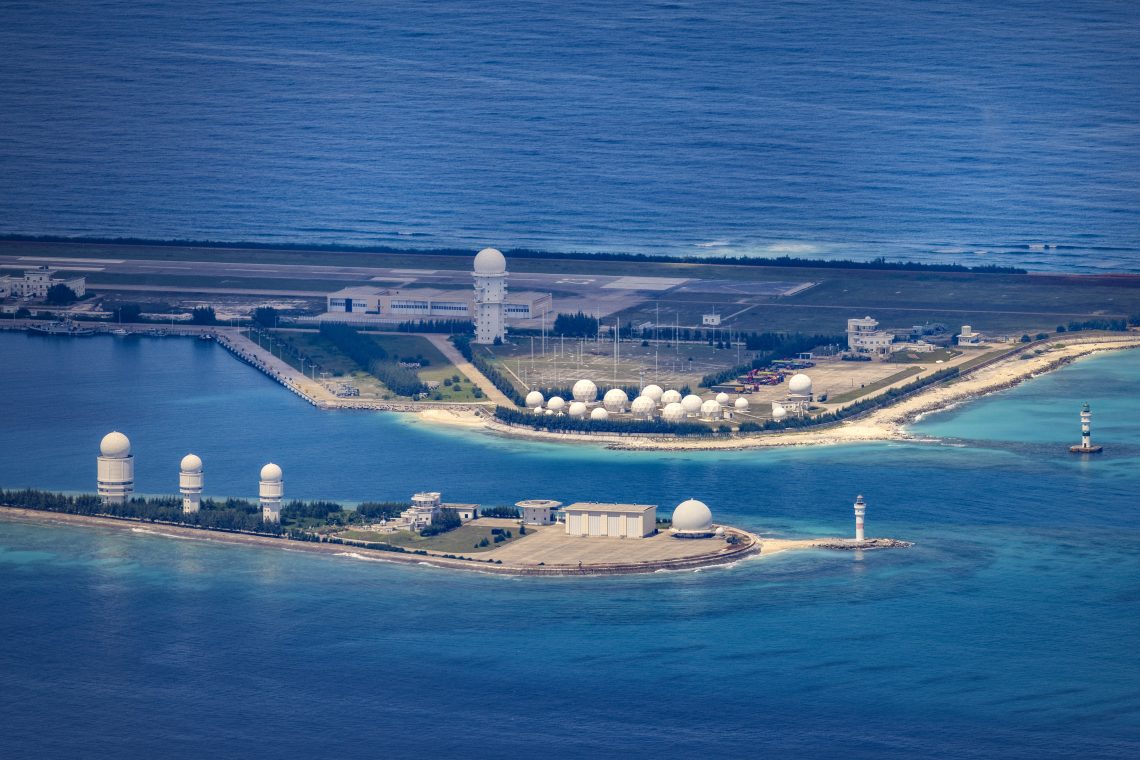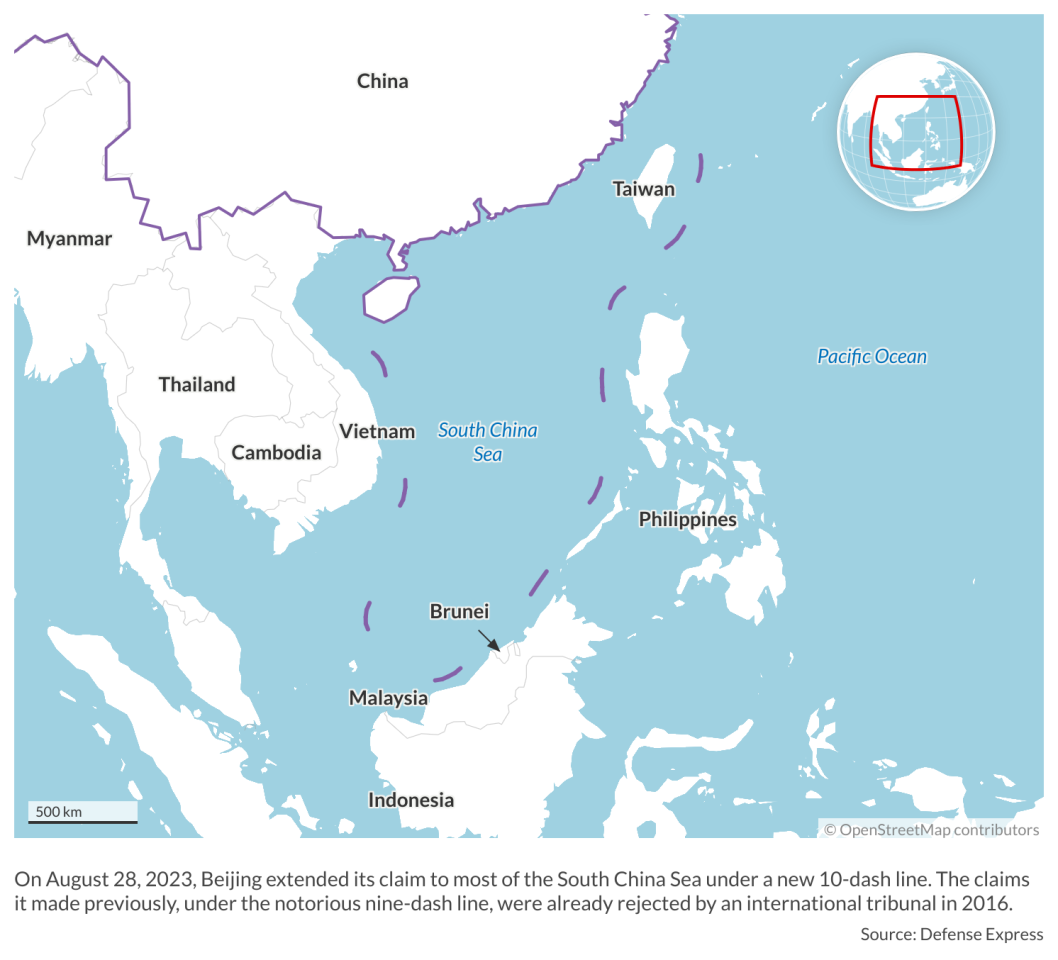Beijing’s claims in the South China Sea roil the Philippines
China, backed by a strong maritime militia, is asserting its dominance in one of the world’s most disputed and strategic waterways.

In a nutshell
- In violation of international law, Beijing claims most of the sea as its own
- China’s militarization of the waterway is raising tensions with many nations
- The actions increase the risk of a military confrontation in a major trade route
Tensions between China and the Philippines in the South China Sea are on the rise. The dynamics warrant wider attention given the waterway’s importance to global trade, its connection to intensifying United States-China competition and the international principles at stake. But they also raise the more challenging question of how relations between Manila and Beijing are likely to proceed in the coming years. The fraught relationship has led to numerous rows in the South China Sea. Beijing’s aggressive stance has also triggered disputes with Brunei, Malaysia, Vietnam and Taiwan.
In the 1990s, China triggered conflict by seizing Mischief Reef in Manila’s exclusive economic zone after the U.S. closed military bases in the Philippines. The situation deteriorated again in the early 2010s when China seized Scarborough Shoal from the Philippines. Manila responded by filing an international legal case against Beijing and signing a new defense pact with Washington.
Although Rodrigo Duterte, president from 2016-2022, initially tried to align Manila closer with China and slow U.S.-Philippine cooperation, Beijing continued its harassment of Philippine fishing vessels and security forces. The situation has not improved since Mr. Duterte’s successor Ferdinand Marcos Jr. – son of ousted Philippine dictator Ferdinand Marcos – took office last year.
2016 international tribunal rules against China’s claims
The recent flare-ups between China and the Philippines in the South China Sea are part of a broader pattern of growing Chinese aggression in reinforcing its nine-dash line under which Beijing claims most of the South China Sea as its own. An arbitration tribunal of the United Nations Convention on the Law of the Sea in The Hague in 2016 ruled that Chinese claims in the nine-dash line are illegal. But President Xi Jinping rejected the tribunal’s finding that the parts of the sea that China covets are neutral international waters or part of the exclusive economic zones of other nations.
Also by Prashanth Parameswaran
The future of Indonesia-China relations after Jokowi
Incidents flare over the disputed Spratly Islands
Sino-Philippine tensions have largely focused on the Second Thomas Shoal, a submerged reef that is part of the disputed Spratly Islands, which is claimed by multiple countries including China and the Philippines.
Over the past year, Chinese vessels have routinely blocked Philippine ships to undermine Manila’s position in the South China Sea. Beijing has also fired water cannons and used blinding lasers as part of its tactics. Similar incidents have occurred before, but the Philippines is now publicizing the incidents more than during the Duterte administration.
This pattern of Chinese behavior has also become routine across the South China Sea in recent years, from vessels intruding into Vietnam’s exclusive economic zone for long stretches to protests registered against energy exploration by Malaysia and the Philippines.
Facts & figures
A foreign policy tilt toward the U.S. amid Beijing’s coercion
These tensions matter due to their wider geopolitical significance. President Marcos, far from continuing Mr. Duterte’s pro-China bent, has instead swung the Philippines closer to the United States. He has agreed to new U.S. defense sites, plugged Manila into security exercises, signed a nuclear energy cooperation pact and is even more vocal about his country’s interests in Taiwan. This has rankled Beijing but fed into U.S. efforts to build closer partnerships in its competition with China. The administration of U.S. President Joe Biden has repeated that military force against the Philippines would trigger a U.S. response under the U.S.-Philippine military alliance.
China’s actions have also reenergized intraregional conversations among more forward-looking members of the Association of Southeast Asian Nations (ASEAN) about how to manage Beijing’s actions, as a seemingly never-ending quest for a binding code of conduct with Beijing inches forward only incrementally. For example, in August, China’s issuance of a new 10-dash line map, extending its territorial claims further around Taiwan and even into Indian territory, just ahead of a round of ASEAN summitry, produced a rare string of quick and united diplomatic protests from Brunei, Indonesia, Malaysia, the Philippines and Vietnam.
Moving forward, the broader question is how Sino-Philippine tensions in the South China Sea might evolve during the rest of President Marcos’s single six-year presidential term, which lasts until mid-2028. This question will play out amid other domestic, regional and global realities. Domestically, while Mr. Marcos’s headwinds now largely revolve around cost-of-living issues and some fallout from his bid to rebrand the Marcos family name, his administration will nonetheless face a challenge in sustaining a tougher posture against Beijing in the democracy with diverse voices, some of whom still see reward in economic engagement with China despite the risks. There are worries in Manila and in some other Southeast Asian capitals about where the South China Sea issue will fit on the ASEAN agenda in 2024, with the body’s annually rotating chairmanship moving from Indonesia to Laos next year before moving back to countries that typically advocate for a stronger stance (Malaysia in 2025, then the Philippines in 2026). At a global level, a potential transition to a new U.S. president after elections in November 2024 could also affect the evolution of U.S.-Philippine ties and Indo-Pacific policy, even if their general trajectories remain unchanged.
Scenarios
Three scenarios are possible.
Most likely: The status quo of periodic coercion continues
The first scenario, and the most likely one, is continuity. China will undertake periodic coercion against the Philippines. But Beijing will be careful not to undertake military actions that might trigger direct U.S. intervention which would result in conflict.
Meanwhile, the Philippines, which is much weaker militarily than Beijing, will continue pursuing what it views as routine activities like resupply operations as best it can while also seeking help from like-minded partners such as Australia, Japan and the U.S. to spotlight, protest and counter aggressive Chinese activities. Manila may also continue to raise this issue at ASEAN fora.
Yet at the same time, Manila would also avoid taking overly risky actions toward Beijing. From a Philippine perspective, a perceived reckless response to Chinese actions in the eyes of others might either play into Chinese arguments that the Philippines is changing the status quo or might weaken the case for the U.S. fully supporting Manila in the South China Sea.
Somewhat likely: South China Sea tensions escalate
The second scenario is the escalation scenario. Though this scenario may have been seen as less likely even a year ago, it has become more of a source of worry in the past few months. In this scenario, we would see the action-reaction dynamic between China and the Philippines noted above not just continue, but escalate to a potential crisis. Beijing’s coercive actions could grow bolder as its patience wears thin. It could begin not just obstructing and harassing Philippine vessels, but even sparking small collisions, boarding them, or detaining some of the crew under a real or false pretext.
In response, the Philippines and its partners may feel compelled to escalate their reaction as well. This could take various forms, including more regularized assistance of Philippine resupply missions out to Second Thomas Shoal. The Philippines could also try to reinforce its outpost on the shoal sometime in the future to strengthen its claim. Any of these actions would in turn increase the risk that Beijing’s obstruction of one of these missions results in a potential accident, miscalculation or deliberate initiation of conflict.
Unlikely for now: Tensions ease
The third scenario is cooling. This may seem unlikely for now, but the past ebbs and flows in how China, the Philippines and other external players like the U.S. have behaved on the South China Sea question suggest that it would be myopic to only extrapolate linearly from current developments.
Under this scenario, periodic China-Philippine tensions would continue in the South China Sea. But Beijing and Manila would at least find a way to routinely manage cycles of potential tensions that periodically emerge through events such as Philippine resupply missions to Second Thomas Shoal or the movement of fishermen in Scarborough Shoal. This is most likely to happen due to some sort of give-and-take arrangement both leaders are able to work out on specific flashpoints or behaviors. It may also be paired with more diplomatic and economic incentives coming from Beijing.
Both sides will need to be creative in designing these arrangements, particularly since there will be skepticism after the unrealized benefits from Mr. Duterte’s China pivot and President Marcos’ earlier efforts to engage with Beijing. Past Sino-Philippine South China Sea tensions also suggest that while cooling measures may work for a while, they are difficult to sustain when tensions rise again.
For industry-specific scenarios and bespoke geopolitical intelligence, contact us and we will provide you with more information about our advisory services.










